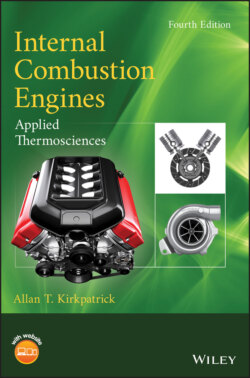Читать книгу Internal Combustion Engines - Allan T. Kirkpatrick - Страница 31
Intake and Exhaust Valve Arrangement
ОглавлениеGases are admitted and expelled from the cylinders by valves that open and close at the proper times, or by ports that are uncovered or covered by the piston. There are many design variations for the intake and exhaust valve type and location. Poppet valves (see Figure 1.14) are the primary valve type used in internal combustion engines since they have excellent sealing characteristics. As shown in the pushrod configuration of Figure 1.14, springs are used to return the valve to a closed position. Sleeve and rotary valves have also been used, but do not seal the combustion chamber as well as poppet valves.
The poppet valves can be located either in the engine block or in the cylinder head, depending on airflow, cooling, and manufacturing considerations. Older engines and small four‐stroke engines have the inlet and exhaust valves located in the block parallel to the cylinders, a configuration termed under‐head or L‐head. This configuration provides good cooling to the valves from the engine block coolant, however with undersquare (bore stroke) engines the maximum valve diameter is limited, resulting in poor volumetric efficiency. The F‐head configuration positions the intake valve in the cylinder head just above the cylinder, increasing the volumetric efficiency, with the exhaust valve remaining on the side.
Currently, most engines use valves located in the cylinder head, an overhead or I‐head configuration, as this configuration has allows increased valve diameter resulting in good inlet and exhaust flow characteristics. However, overhead valves are more difficult to cool than L‐head valves.
Figure 1.14 Poppet valve assembly. (Adapted from Taylor 1985.)
The valve timing is controlled by a camshaft that rotates at half the engine speed for a four‐stroke engine. Lobes on the camshaft along with lifters, pushrods, and rocker arms control the valve motion. The inlet valves in early (circa 1910) engines were spring loaded, and were opened during the inlet stroke by the atmosphere‐cylinder pressure differential. Most automotive engines currently use an overhead camshaft to eliminate pushrods and simplify the valve train.
A valve timing profile is shown in Figure 1.15. The valve opening and closing angles are not necessarily symmetric about top and bottom dead center, due to fluid flow considerations discussed in Chapter 05. The valve timing can be varied to increase volumetric efficiency through the use of advanced camshafts that have moveable lobes, or with electric valves. With a change in the load and speed, the valve opening duration and timing can be adjusted to optimize power and/or efficiency.
Figure 1.15 Poppet valve timing profile. (Courtesy of Competition Cams, Inc.)
